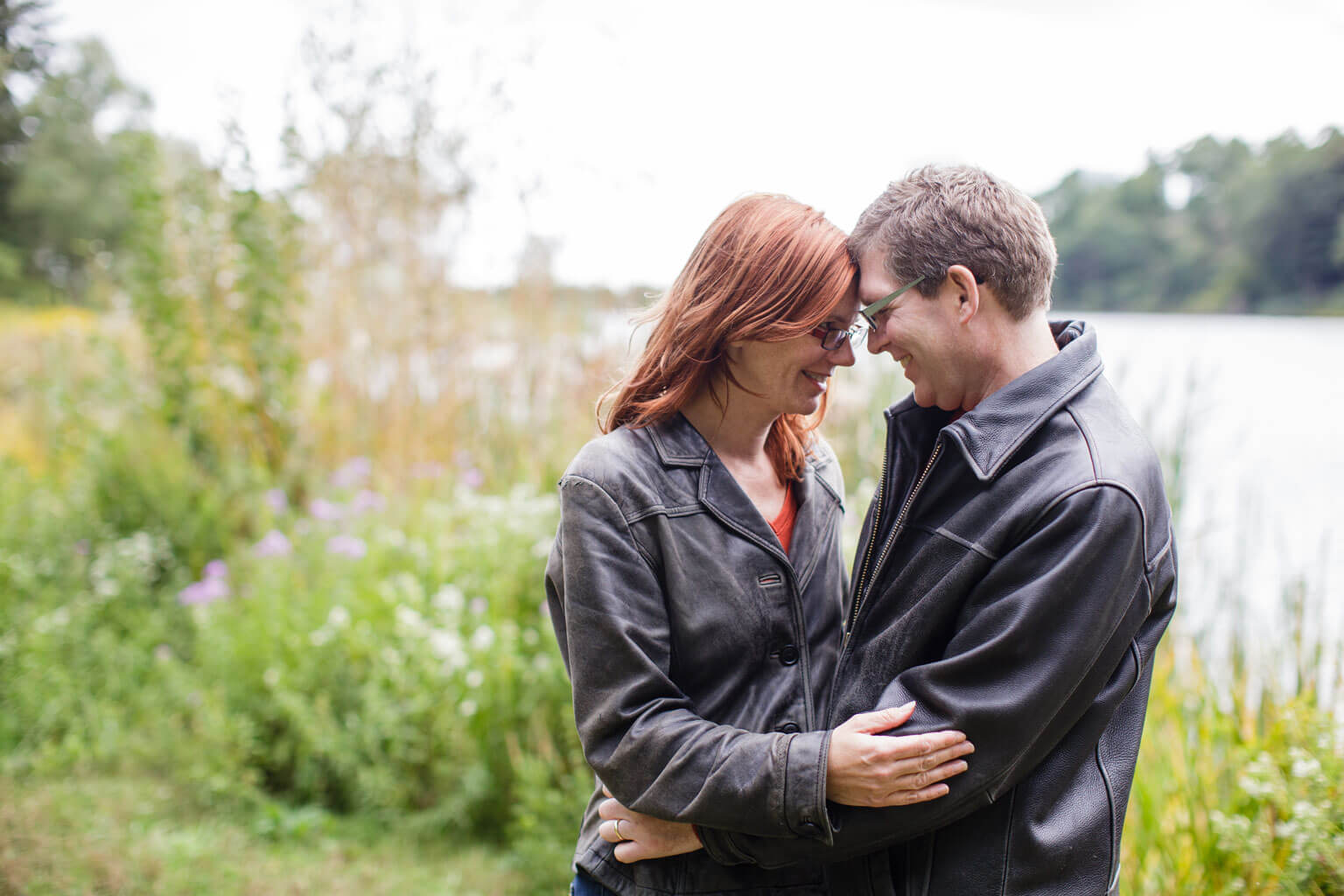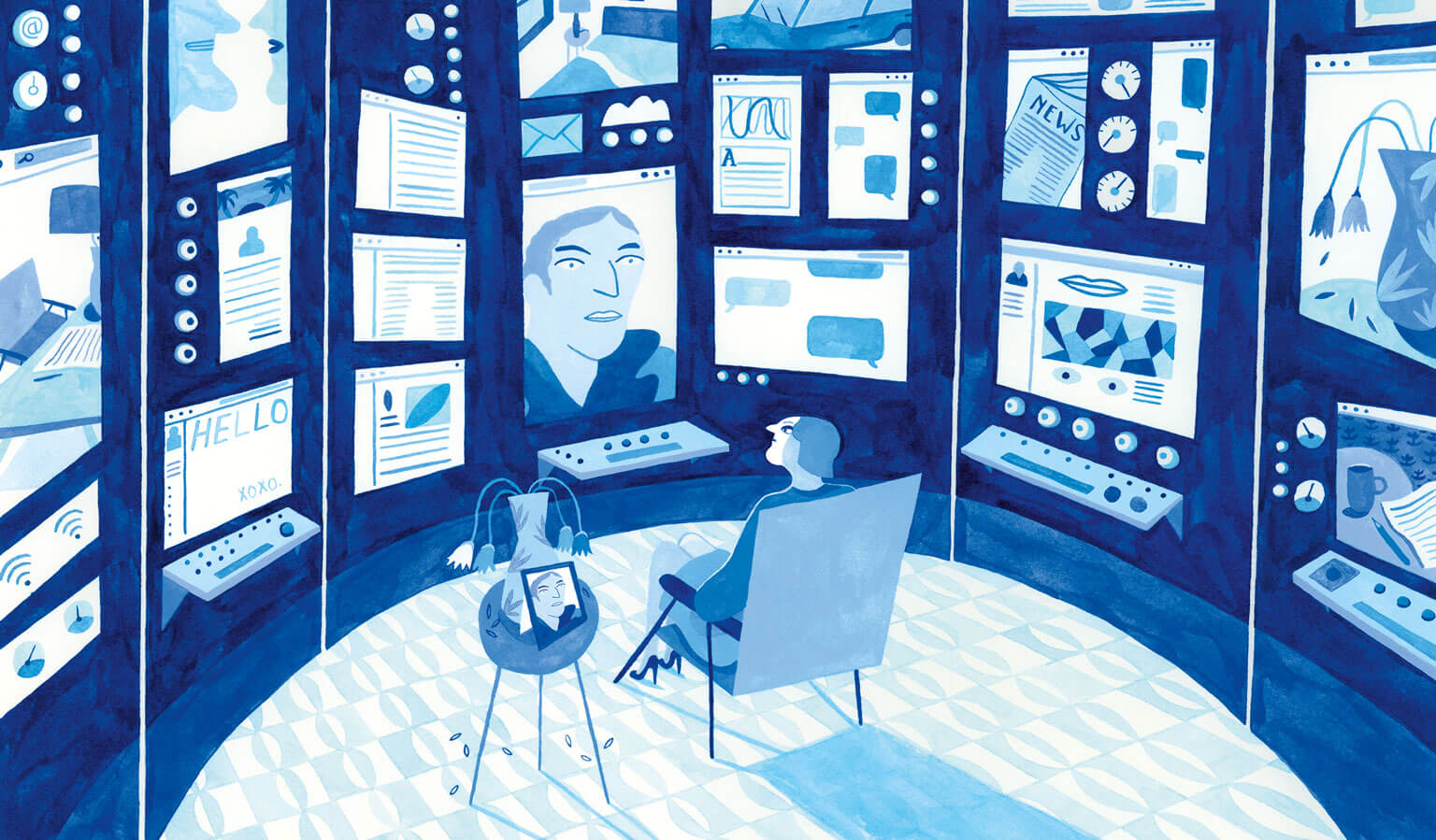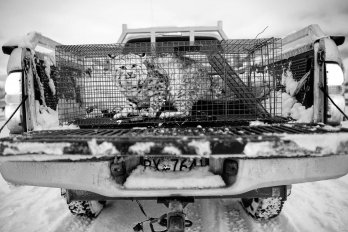For the past few months I have been searching through tweets, emails, Facebook posts, and text messages for a missing person. He isn’t a stranger. He’s my husband and the father of my two children. And he’s not really missing. He’s dead.
Often, late at night after I put our kids to bed, I begin my hunt for Jonathan. I reread emails about mundane dental appointments or brunch dates. “Whose job is more important today?” reads one, sent when a child needed to be picked up early. I linger over quick asides, our kids’ pet names, and his simple sign-off, “love JJ.” Each time I find another morsel, some note that makes me smile, I can almost hear him. But I know I am trying to do the impossible: to reanimate the love of my life word-by-word, tweet-by-tweet, text-by-text.
My husband was a writer. His voice, no matter what the medium, was distinctive and clear. He made wry observations in a few crisp words. We met in journalism school in Winnipeg. “I am strangely attracted to a badly dressed man,” I thought when I first met him. He needed a haircut, and he wore runners and rugby shirts he got from playing the game. I hated sports. We took the same car pool, where our daily commute became a rolling, laughing ride through the streets. Jonathan’s biting wit earned him the sarcastic moniker, Sunshine.
At school we learned about interviewing, accuracy, and storytelling while meeting high-pressure deadlines. We both ended up interning at a local newspaper where only one computer was connected to the Internet—and using it was regarded as a suspicious waste of time. Email was new.
Soon after graduation, eager to begin our careers, Jon took a job as a reporter in Edmonton while I started working as a managing editor at a news and entertainment weekly. We were still just friends, but I felt hollow when he moved away. One of the best perks of my job wasn’t the free theatre tickets but a computer with Internet access and an email address. I quickly connected with Jon and two members from the car pool—each of us with a new job and a new email account.
The group emails resumed the banter of the long icy drives to school. Each writer tried to outwit the other. I teased Jon for his ineptitude at dating in an email with the subject line, “Why Jonny Can’t Breed.” His hilarious responses to all our barbs became the highlight of my day. My heart would jump when I saw his name appear in my inbox.
One summer day, Jon came home for a visit. We went for a walk and I told him I was crazy about him. We started dating immediately.
Our long distance relationship was equally exciting and excruciating. A plane would land, we would hug in the airport, and then launch into a whirlwind weekend of movies and dinners. But always halfway through a visit I would begin to crash, feeling the impending goodbye. And far too soon we’d be back in the airport, hugging goodbye.
We filled the physical gap with frequent emails about our days, what stories we were working on, and our unreserved support for each other in disagreements with our bosses. It took years before we lived in the same city. We broke up, got back together, and then finally both landed jobs in Toronto. After one year sharing an address, we got engaged. We married in Winnipeg on an extremely cold December day.
We were a media-driven household, consuming newspapers at breakfast before starting long, unpredictable days, Jon as a print reporter and me as radio reporter and producer. We never knew who would be home for dinner. We understood when a movie night was cancelled because of a breaking story.
We were highly competitive and taunted each other on slow news days with emails asking about made-up events: “Do you know about the thing, can’t believe it blew up?” or “Did you get to talk to that guy? Amazing story he has.” If we showed up at the same scrum, we would smile a quick hello, then ask our questions and run back to our respective newsrooms trying to beat each other’s story.
After three years in Toronto, Jon went to Australia to cover the Rugby World Cup. While he was away, I flew to Calgary for a wedding, where I called Jon with some news of our own: I was pregnant. We’d been hoping to start a family. In the first few emails we dubbed our tiny offspring Grain. But only a week and a half later, doctors told me I was having a miscarriage. Jon was still away, trying as best he could to support me through phone calls and emails. Everything would be okay, he said. But bad turned to worse when I collapsed from a ruptured ectopic pregnancy and was rushed for emergency surgery. Through the time difference, the sadness and the haze of painkillers, email continued to be our connective tissue.
We were fortunate our dream of a family eventually came true. We welcomed our son in 2004 and our daughter in 2007. Jon crafted news release birth announcements where we were identified as CEO and president of Jenkaway Inc., a merger of our last names.
The email notice of our first born included the line: “The launch, widely expected for the past nine months, went smoothly and stock in the new division opened trading at 9 pounds 12 on the London exchange.” Three years later, a new “operating system” was “unveiled to a rapturous industry after a labourious operation that went off with surgical precision at exactly 4:53 p.m. EST.”
Jon worked newsroom shifts that allowed him to sometimes be my co-pilot during the day while I was on maternity leave. And when he wasn’t home, he sent me sanity-saving emails from the outside world, while I gave him the scoop on grins, crawls, and spit ups. When I returned to work, we wrote each other hasty emails about daycare drop-offs, pick-up times, and the critical details of a young, working family sprinkled with in-jokes.
Over the years, Jon became a political reporter with a busy online presence. He effortlessly turned the news of the day into acerbic one-liners on Twitter. When he covered elections he would be away for weeks, and I wouldn’t know where he was on the campaign trail until I looked at his tweets. I’d piece together his day 140 characters at a time: what city he was in or if he was on a bus or a plane.
One day I was nervously waiting for him in an endoscopy clinic. Jon was late for his appointment. When he finally arrived, he told me he had been stuck in an elevator, but didn’t call because he thought I would have seen his play-by-play tweets.
Help! I'm trapped in a Queen's Park elevator. With no politician to grill. #onpoli
— Jonathan Jenkins (@jmdjenkins) September 12, 2013
I didn’t read the elevator posts until weeks later, when I needed a reminder of when things were as simple as tweeting a funny moment. While Jon was still waking up from his throat scope, the doctor took me aside in the hallway and gave me the worst news I’d ever heard. Jon had esophageal cancer. I could say everything changed that day but I can’t isolate change to one day. Everything changed and kept changing. Dramatically. Terrifyingly. Helplessly.
We found a new way to communicate: I would take notes at doctor’s appointments and write a first draft email to update family and friends, which Jon would proofread and edit. In those emails, we shared our hopes for Jon’s treatment regime. We also explained how we told our kids their dad has cancer using the three Cs: the kids didn’t cause it, cancer is not catchy, and they will always be cared for. It was important for us to make sure our friends and family had a vocabulary for approaching the topic with their own children or for talking with ours.
The intense chemotherapy drained Jon. He lost his mop of hair. He couldn’t eat because he couldn’t swallow. He stopped being able to work. Six months after his diagnosis we prepared for a major, daylong surgery. While Jon went into the OR, I found a couch in the waiting room. Only one hour after the procedure started, I was told the surgeon was coming to see me. I knew Jon was either dead or dying.
I began to cry as I was escorted into a small, boxy room inside the main waiting area. I frantically tried to call our family who was staying at our house, but my cellphone kept cutting out and my texts couldn’t seem to escape that little room. When the surgeon arrived, she told me the cancer had spread too far for surgery to treat. I went to Jon’s bedside and held his hand as the doctor told him the life-altering prognosis.
Shortly after we found out Jon was dying, we sent the toughest email I have ever written. I read it to Jon so he could edit it—the story of his impending death. It included our determined resolve to enjoy each and every day, no matter how many we had.

I have now been living with one foot in the past, re-reading traces of a journey that ended on April 28, 2014.
The first line of Jon’s obituary read: “Family man, Winnipeg Jets fan and journalist Jonathan Jenkins died after a brutal home invasion—cancer crept in and robbed him of his life in his 50th year.” The line first appeared on Facebook, and then on Twitter. A cascade of messages took over my feeds. Then links to the newspaper obit were shared, with kind words ricocheting around the Internet. Jon’s name began trending on Twitter.
He was everywhere and nowhere.
At first I was uncomfortable with the online grieving. When people clicked “like” on Jon’s obit after it was posted to Facebook, it felt remote and impersonal as if someone was taking something that belonged to the kids and me. But digital death notices and online goodbyes are part of modern love. When I saw the names of people I had never met posting their condolences on a friend’s page, I understood it. When I die, I want my friends to be comforted too.
After he died, Jon’s online presence grew and then faded into the ether. Now, when I Google his name late at night, I see he has slipped further and further down in the search results.
Curiously, Jon keeps gaining followers to his Twitter account. And his email accounts keep filling up with spam: “It’s been a long time since we heard from you, Jon,” and “Where have you been? You can still get a deal on . . . ” And once his e-book subscription sent him an email with a title it said was chosen just for him: “Heaven is for Real.” I know these things would have made him laugh.
Sometimes I forward emails from Jon’s account to mine to keep track of something important. And even though I know I’ve just sent myself an email from his account, my heart still leaps when I see his name appear in my inbox.
As much as I want to hold onto virtual pieces of Jon, estate business involves officially erasing your beloved. I’ve returned his driver’s licence and health card, and was sent back his passport with a cold “cancelled” stamp across the first page. While registering the kids for summer camps online, Jon’s name and details often auto-fills the forms and I have to put my cursor in each field and hit delete, delete, delete.
Before he died, Jon shared the important passwords with me, but we were too busy living the last of his days to get caught up in paperwork. When he was gone, I was astounded by how many other passwords I needed to know for basic online transactions like continuing a newspaper subscription or downloading a movie for the kids.
He had taken care of all the technical stuff in our house. Now I’m reluctantly teaching myself things I never wanted to learn about: uploading pictures, upgrading operating systems, removing viruses, and keeping Apple TV running. (This particular achievement is not yet reached, as the TV seems unable to accept Jon’s death, and my new role as chief tech officer.)
As I navigate being a solo parent, I’m building an archive for the kids of their dad: copies of his tweets, Facebook posts, and emails—a breadcrumb trail of their father’s spirit for them to follow. But I worry about storing it on a hard drive or on a cloud server, or even printing it? Our house is filled with obsolete technology, a reminder that Jon could disappear further when computer systems change.
A few weeks after Jon died, I dropped my iPhone and the glass shattered. I used packing tape to try to save the screen, and carried it around like a bandaged bible. I comforted myself by flipping through text messages and time-travelling back to before we ever used words like cancer, chemo, morphine, or palliative care.
I tried unsuccessfully to transfer those texts with date stamps to my email. I bought an app, but it didn’t work. Then, one day when the phone was in my pocket as I was shovelling snow, water from a melting snowflake slipped under the tape and washed away most of the screen. The demise of my phone was just another kind of ending. How many virtual strands should a person hold on to? When is it time to retire Twitter and Facebook accounts? When should you say goodbye to old, broken cellphones?
And what else should be kept? A shirt our son might grow into, or the pink tie Jon wore when our little girl sat perched in a pink dress on his lap in the press gallery of the legislature? What about my wedding ring?
I always called Jon my good thing. We said our love would last a lifetime, and for one of us it did. The echoes of him, the pulses of his digital presence, help me get through the days. Every time I search through my emails for the words “love JJ” I know that with every click I will be filled with both comfort and torture.
I often think of the last text he sent me, four days before he died. It’s a question I struggle with each day.
“Is everything okay?”





